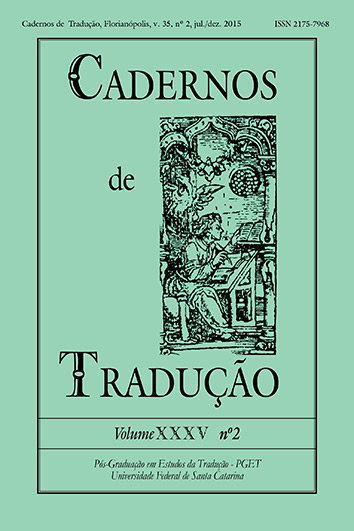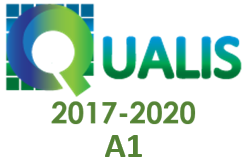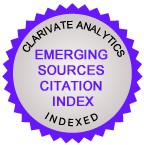Translating the figures of sound of Utopia's book I into brazilian portuguese
DOI:
https://doi.org/10.5007/2175-7968.2015v35n2p211Abstract
Utopia’s Latin text is full of sound and meaning resources, few of them really taken into account in translations of this work to other languages. These resources are important – even if scarcely noted by translators – because, as pointed out by Edward Surtz (1967), if the manner in wich a writer expresses himself is moulded by ideas, the ideas are also moulded by tools of expression. Their being indissociable was already perceived by Juan Vives in the Sixteenth century, when he gave his reasons for reading Utopia: because of both the language and the subject. Nevertheless, one of the least studied aspects of the libellus aureus is precisely the specificity of the language in which it was written, its style, and its particularities. Among them there is the musicality, or rather the “physical aspects” of Morean language, its “rhymes and rhythms”, on the words of André Prévost (1978). This paper aims at appreciating some “figures of sound” (as said by Surtz) of Utopia’s book I. For that purpose, we will compare the Latin passages with two Brazilian translations, the most recent Portuguese version as well as my own.
References
BRAREN, Ingeborg. “Por que Sêneca escreveu epístolas?”. Letras clássicas, 3, 1999, p. 39-44.
CAVE, Terence (Ed.). Thomas More’s Utopia in early modern Europe. Paratexts and contexts. For the project “Dislocation: practices of cultural transfer in the early modern period” at the University of Oslo. Manchester/New York: Manchester University Press, 2012.
DE PIETRO, Matheus Clemente. Faces da “harmonia” nas Epistulas morales de Sêneca. Dissertação (Mestrado). Campinas: Universidade Estadual de Campinas, 2008.
DE PIETRO, Matheus Clemente. Noções estoicas de harmonia no De vita beata de Sêneca. Tese (Doutorado) Campinas: Universidade Estadual de Campinas, 2013.
FARAL, Edmond. Les arts poétiques du XVIIe et du XIIIe siècle. Recherches et documents sur la technique littéraire du Moyen Âge. Paris: Champion, 1962.
FERREIRA, Aurélio Buarque de Holanda. Novo dicionário da língua portuguesa. 2ª ed. ver. e aum. Rio de Janeiro: Nova Fronteira, 1986.
GLEI, Reinhold F. Philologen in Utopia. Neulateinisches Jahrbuch, 2, 2000, p. 39-55.
HOVEN, René. Essai sur le vocabulaire néo-latin de Thomas More. In: Lexique de la prose latine de la renaissance. Dictionary of Renaissance Latin from prose sources. Deuxième édition revue et considérablement augmentée/Second, revised, and significantly expanded edition. Avec la collaboration de/Assisted by Laurent Grailet. Traduction anglaise par/ English translation by Cohen Maas. Revue par/ Revised by Karin Renard-Jadoul. Leiden-Boston: Brill, 2006, p. 659-683.
HUNT, Lydia. The first Spanish translation of Utopia (1637). Moreana, vol. 28, n. 105, 1991.
KLOPSCH, Paul. Neo-Latin. In: Brill’s New Pauly. Antiquity volumes edited by: Hubert Cancik and Helmuth Schneider. Brill Online, 2012. Reference. Universitaetsbibliothek Heidelberg. Acessado em 04/08/2012. http://referenceworks.brillonline.com.ubproxy.ub.uni-heidelberg.de/entries/brill-s-new-pauly/utopia-e1226510
KLUGE, O. Die neulateinische Kunstsprache. Glotta, 1935, XXIII.
LAUSBERG, Heinrich. Handbook of literary rhetoric: a foundation for literary study. Foreword by George A. Kennedy. Translated by Matthew T. Bliss, Annemiek jansen, David E. Orton. Ed. by David E. Orton & R. Dean Anderson. Leiden; Boston; Köln: Brill, 1998.
LAUSBERG, Heinrich. Elementos de retórica literária. Tradução, prefácio e aditamentos de R. M. Rosado Fernandes. 5ª ed. Lisboa: Fundação Calouste Gulbenkian, 2004.
MACK, Peter. A history of Renaissance rhetoric, 1380-1620. New York: Oxford University Press, 2011.
MARC’HADOUR, G. Thomas More ou la sage folie. Paris: Seghers, 1971.
MARC’HADOUR, Germain. More's Utopia: Comparing Seven Recent Translations. Moreana, vol. 38, n. 146, 2001.
McCUTCHEON, Elizabeth. Thomas More, Utopia: Latin Text and English Translation - George M. Logan, Robert M. Adams, and Clarence H. Miller (Cambridge). [Recension] Moreana, vol. 33, n. 127-128, 1996.
McCUTCHEON, Elizabeth. Denying the contrary: More’s use of litotes in the Utopia. Moreana, 31-32, 1971, p. 107-122.
McCUTCHEON, Elizabeth. Denying the contrary: More’s use of litotes in the Utopia. In: Essential articles for the study of Thomas More. Edited with an introduction and a bibliography by R. S. Sylvester and G. P. Marc’hadour. Hamden, COnnecticut: Archon Books, 1977, p. 263-274.
McCUTCHEON, Elizabeth. My dear Peter. Ars poetica and hermeneutics for More’s Utopia. Angers: Moreana, 1983.
McCUTCHEON, Elizabeth. Ten English translations/Editions of Thomas More’s Utopia. Utopian studies, vol. 3, n. 2, 1992, p. 102-120.
McCUTCHEON, Elizabeth. More’s rhetoric. In: Logan, George M. (Ed.). The Cambridge companio to Thomas More. Cambridge: Cambridge University Press, 2011, p. 46-68.
McCUTCHEON, Elizabeth. Thomas More, Utopia. Translated, edited and introduced by Dominic Baker-Smith. Moreana, vol. 50, n. 193-194, 2013, p. 273-286.
MILLER, Clarence. The English translation in the Yale Utopia: some corrections. Moreana, 9, 1966, p. 57-64.
MILLER, Clarence. Style and meaning in More’s Utopia: Hythloday’s sentences and diction. In: Humanism and style. Essays on Erasmus and More. With na Introduction by Jerry Harp. Bethlehem: Lehigh University Press, 2011.
MONSUEZ, R. Le Latin de Thomas More dans Utopia, Annales publiées par la Faculté des Lettres et Sciences Humaines de Toulouse, Nouvelle Série, t. II, fasc. I, janvier, 1966, Caliban, 3, p. 35-78.
MOORE [sic], Thomas. A Utopia. Tradução e prefácio de Luiz de Andrade. Rio de Janeiro: Athena, 1937.
MORE, Thomas. MORE, Thomas. Utopia. In: Surtz, Edward S.J.; Hexter, J.H. (ed.). The Complete Works of St. Thomas More, vol. 4. New Haven and London: Yale University Press, 1965.
MORE, Thomas. L’Utopie. Présentation, texte original, apparat critique, exegèse, traduction et notes de André Prévost. Paris: Mame, 1978.
MORE, Thomas; ERASMO. A Utopia. [1ª ed. 1972] Tradução e notas de Luís de Andrade. Elogio da loucura. Tradução e notas de Paulo M. Oliveira. 2ª ed. São Paulo: Abril, 1979.
MORE, Thomas. L’Utopie ou Le Traité de la meilleure forme de gouvernement. [1ª ed. 1936] Texte latin édité et traduit par Marie Delcourt avec des notes explicatives et critiques. Genève: Droz, 1983.
MORE, Thomas. Utopia. Edited by George M. Logan and Robert M. Adams. Revised edition. [1ª ed. 1989] Cambridge: Cambridge University Press, 2002.
MORE, Thomas. Utopia. [1ª ed. 1993] George M. Logan e Robert M. Adams (orgs). Edição revista e ampliada. Tradução Jefferson L. Camargo e Marcelo B. Cipolla. São Paulo: Martins Fontes, 2009.
MORVS, Thomas. Vtopia ou A melhor forma de governo. Tradução, com prefácio e notas de comentário de Aires A. Nascimento. Estudo introdutório de José V. de Pina Martins. Lisboa: Fundação Calouste Gulbenkian, 2009.
MORE, Thomas. Utopia. Translated with an introduction by Clarence H. Miller. New Haven & London: Yale University Press, 2001.
MORRISH, Jennifer. A note on the Neo-Latin sources for the word ‘utopia’. Humanistica Lovaniensia. Journal of neo-latin studies, vol. L, 2001, p. 119-130.
NAGEL, Alan F. Lies and the inimitable inane: contradiction in More’s Utopia. Renaissance quaterly, 26, 2, 1973, p. 173-180.
Oxford latin dictionary. Oxford: Oxford University Press, 1968.
PEGGRAM, Reed E. The first French and English translations of sir Thomas More’s Utopia. The modern language review, 100, 2005, p. 51-61.
PRÉVOST, André. Le texte de l’Utopie (Les premières éditions de l’Utopie; La langue latine de l’Utopie; Les traductions de l’Utopie; Directives pour la lecture du fac-similé). In: More, Thomas. L’Utopie. Présentation, texte original, apparat critique, exegèse, traduction et notes de André Prévost. Paris: Mame, 1978, p. 215-275.
RIBEIRO, A. C. R. As traduções brasileiras de A Utopia, de Tomás Morus. In: Anais do II Encontro Tricordiano de Linguística e Literatura, Memento, 2012, 3. p. 4-12.
RIVOLETTI, Christian. Le metamorfosi dell’Utopia. Anton Francesco Doni e l’immaginario utopico di metà Cinquecento. Lucca: Maria Pacini Fazzi Editore, 2003.
SILVEIRA, Fabiana Lopes da. Praecepta e Decreta na Epístola 94 de Sêneca. Dissertação (Mestrado em Linguística). Campinas: Universidade Estadual de Campinas, 2014.
SYLVESTER, R. R. Si Hythlodaeo credimus. Vision and revision in Thomas More’s Utopia. Soundings: An interdisciplinary journal, vol. 51, n. 3, 1968, p. 272-289.
SURTZ, Edward L. Utopia as a work of literary art; Vocabulary and diction in Utopia. In: More, Thomas. Utopia. In: SURTZ, Edward S.J.; HEXTER, J.H. (ed.). The Complete Works of St. Thomas More, vol. 4. New Haven and London: Yale University Press, 1965, p. cxxv-cliii; 579-582.
SURTZ, Edward L. Aspects of More’s latin style in Utopia. Studies in the Renaissance, 14, 1967, p. 93-109.
UEDING, Gert (Ed.). Historisches Wörterbuch der Rhetorik. Tübingen: Max Niemeyer Verlag, 1992.
VAN DER POEL, Marc. The latin declamatio in Renaissance Humanism. Sixteenth century journal, XX, 3, 1989, p. 471-478.
VON ALBRECHT, M. Seneca’s Language and Style I. Hyperboreous, v. 14, 2008.
WILLS, J. Repetition in latin poetry: figures of allusion. Oxford: Clarendon Press, 1996.
ZANDVOORT, R. W. On translating Utopia. Moreana, v. 4, n. 15-16, 1967, p. 137-140.
Downloads
Published
How to Cite
Issue
Section
License
Copyright (c) 2015 Cadernos de Tradução

This work is licensed under a Creative Commons Attribution 4.0 International License.
Copyright Notice
Authors hold the copyright and grant the journal the right for their articles' first publication, being their works simultaneously licensed under the Creative Commons Attribution License (CC BY), which allows the sharing of such works with its authorship acknowledged and its initial publication in this journal.
Authors are allowed to enter into separate additional contractual arrangements for the non-exclusive distribution of the journal's published version of the work (e.g., post it to an institutional repository or as a book chapter, with an acknowledgment of its initial publication in this journal).






















































